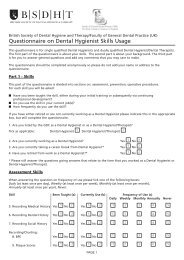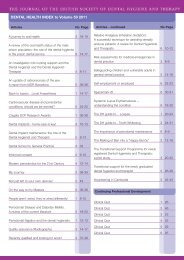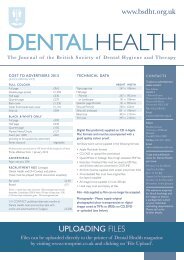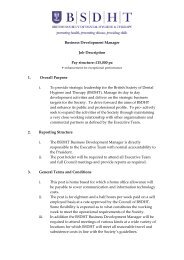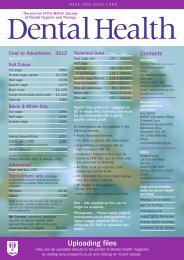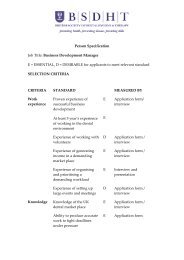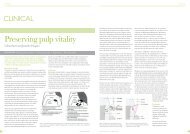Dental Health - British Society of Dental Hygiene & Therapy
Dental Health - British Society of Dental Hygiene & Therapy
Dental Health - British Society of Dental Hygiene & Therapy
- No tags were found...
Create successful ePaper yourself
Turn your PDF publications into a flip-book with our unique Google optimized e-Paper software.
CLINICALFigure 3: Bone grafting optionsType <strong>of</strong> GraftDescriptionAutograft Patient’s own bone harvested from a donor site to be(Autogenous) used in regeneration and preservation procedures.Allograft Bone harvested from the same species, human bone –(Allogenic) cadaveric bone and human tissue usually obtained froma tissue bank used in regeneration and preservationprocedures.Xenograft(Xenogenic)Alloplast(Alloplastic)Bone or tissue transplant from another species- animalused in regeneration and preservation procedures.Synthetic bone, hydroxyapatite and biocompatiblesubstances, with similar properties to bone used inregeneration and preservation procedures.and some synthetic derived productsthat are able to differentiate intobone and tissue with very promisingstudy results. 1,2 They all can be usedalone or in combination based onthe osteogenic, osteoconductive, andosteoinductive principles (figure 2)It’s all about the bone!<strong>Dental</strong> hygienists are in the idealposition to talk to their patients aboutthis exciting time <strong>of</strong> regenerationdentistry. The average hygienist spends30 minutes with patients on a one toone basis. It is imperative that youattain the verbal skills to talk withpatients about the tooth replacementsand the key adjunctive procedures tohelp them retain the bone and obtainthe ideal implant treatment. If teethare lost and not replaced atrophy <strong>of</strong> thebone is apparent in facial aesthetics.Having a conversation with yourpatients on the regenerative proceduresavailable today will help patients makea more informed decision about toothreplacement and bone preservation.The key adjunctive regenerativeprocedures to talk about with yourpatients and set the stage for implantsare; socket preservation, alveolar ridgeand sinus augmentation. Anotheradjunctive regenerative procedureused to correct or regenerate lostbone around an existing implant(s)is referred to as implant dehiscenceor fenestration defect. A dehiscenceis a break in the covering epitheliumleaving an isolated buccal or lingualarea <strong>of</strong> the implant exposed and afenestration is an apical defect. A GBRprocedure is used to retain the implant,therefore adjunctive procedures canalso be used after implants have beenplaced.Socket preservation involves placingbone graft particulate and / or a barriermembrane to the socket <strong>of</strong> an extractedtooth at the time <strong>of</strong> extraction topreserve the alveolar ridge. If a toothsocket is allowed to heal on its own,new bone will form, but with a 25%decrease in width and a 4mm decreasein height in the first year after theextraction. 3,4 Socket preservation isdone to prepare an optimal foundationto place an implant, but should be doneafter each and every extraction.The first step for regeneration startswith the ‘Blood Clot’. Placing boneparticulates in an extraction site willprotect the blood clot which is essentialto the healing process and can alleviatethe post-surgical complication referredto as ‘dry socket’. (figure 4)This can be used alone as socketpreservation especially in cases whereimplants are not treatment planned.Step two involves adding a membranebarrier to prevent the fast movingtissue cells from taking over and allowthe bone cells time to form in thesocket. Both can be used to ‘set thestage’ for implants and provide morepredictable healing, bone preservation,and fewer complications.Figure 4: Step one – place boneparticulates into the socketIt is critical to remove the extractiontooth with minimal damage tothe alveolar bone or s<strong>of</strong>t tissue.Extraction site preservation startswith the surgeon using a periotomeinstrument to manually cut throughthe periodontal ligament (PDL) thatholds the non-ankylosed tooth in place.(figure 5)Figure 5: Example <strong>of</strong> how aperiotome is usedWhat happens if the tooth isextracted and not replaced with animplant?Bone loss continues and the patientmay eventually become edentulousand need a partial or traditionaldenture. In the past we were not ableVolume 51 No 6 <strong>of</strong> 6 November 2012 <strong>Dental</strong> <strong>Health</strong> 13



